#david del real model
Text
Canal de DailyMotion de DAVID DEL REAL
Chistes, frases, anécdotas, fotos de modelaje y apariciones en TELENOVELAS y SERIES. Actualmente subiendo "Chistes de la Selva"
#david del real#david#ese Davis!#Dailymotion#David del Real en DailyMotion#david del real actor#david del real comediante#david del real model#david del real modelo#chistes de la selva#frases#anecdotas#trabalenguas#actor#attor#comedian#comedi#comedy#fun#omd#Dailymotion de David del Real#Chistes de David del Real
6 notes
·
View notes
Text
Mira esto... 👀
Mira esto... 👀 https://pin.it/4mEnNuq
David del Real, foto.
#david del real#daviddelreal#foto#photo#modelo#model#actor#ator#Schauspieler#camisa negra#modelaje#actordetelenovelas#telenovelas#series#comercial#comerciales#foto fija#fotofija
1 note
·
View note
Text
Watching Guillermo del Toro’s Pinocchio
SPOILERS AHEAD
- Wait, the HENSON company? Ok, that’s a sign of quality here.
- I love the models, the animation, the music... can’t wait to see this world!
- Eh... the Great War? Is this set during WWII?
- Wait, is this a musical?
- Stop playing with my heart, I know the boy dies.
- Sebastian’s design is top-notch. Love how he looks like the little gentleman he is. Also, what’s with del Toro and four-armed characters?
- Oh, those creepy eyes... great.
- I’ve said it before with Korra and I’ll say it again: kudos for showing trauma.
- Is that Merlin’s voice? I think it’s Merlin’s voice. (BTW, David Bradley is great in this).
- Ok, that boy is dangerous.
- But look at the way he moves, with his long arms.
- Oh, so Stromboli is French here. He’s not even called Stromboli.
- I read the original book too many years ago, maybe I should check it out again.
- Gregory Mann (Pinocchio) has a lovely singing voice.
- Okay, now he’s dead.
- Ah, the Underworld looks fantastic! And are those Foo-Foos? Wait, what?
- What an imagination. The sphinx in the room full of sand clocks is my favorite part.
- Also, this is the second time he talks to a magic being and doesn’t mention he wants to be a real boy. Maybe he won’t transform in this one?
- They want him to be a soldier! Is there going to be more war in this?
- BTW, that would be great. Enough with sugarcoating history. War is bad. Kids need to know that.
- This boy is learning fast.
- I’ve been enjoying the snippets of Italian and Italian culture.
- I bet that sailor is Gobber’s descendant.
- I’m starting to think there’s not going to be a donkey transformation in this neither. Huh. But the youth camp as the opposite of Pleasure Island hits hard.
- Because maybe that actually happened. They trained little kids in lots of wars.
- Huh... Pinocchio gets his own cross in the pyre. And he was complaining because everybody seems to love JC in the church and but not him and both are made of wood.
- Weird.
- It’s good to see that Gepetto has been eating his meals while he was inside the monster.
- And it’s nice that he can understand Sebastian.
- He’s a smart cookie. Ewan McGregor does a great job.
- Of course he was going to use his only wish to bring Pinocchio back .
- But... no, he’s not a real boy.
- And that’s ok.
- Oh, no, are they’re going to show all the deaths?
- Yep.
- At least, a bittersweet ending done well.
- And Sebastian gets to finish his song.
- BTW, although they all have good voices, some songs were way better than others. Maybe this didn’t have to be a musical?
- But, yeah, a good movie.
64 notes
·
View notes
Photo

Neil Hamilton and Constance Bennett in What Price Hollywood? (George Cukor, 1932)
Cast: Constance Bennett, Lowell Sherman, Neil Hamilton, Gregory Ratoff, Brooks Benedict, Louise Beavers, Eddie Anderson. Screenplay: Jane Murfin, Ben Markson, Gene Fowler, Rowland Brown, based on a story by Adela Rogers St. John. Cinematography: Charles Rosher. Art direction: Carroll Clark. Film editing: Del Andrews, Jack Kitchin. Music: Max Steiner.
Bradley Cooper's 2018 film A Star Is Born is often called a remake of the films by that title starring Fredric March and Janet Gaynor in 1937, James Mason and Judy Garland in 1954, and Kris Kristofferson and Barbra Streisand in 1976. But all four of them can trace their origin to What Price Hollywood?, produced by David O. Selznick and directed by George Cukor in 1932. The name is different but the plot's the same: A successful man in the entertainment business discovers a young woman whom he helps become a star, but as her career ascends, his personal problems send him into a tailspin. if there's any doubt about the link with What Price Hollywood? and at least the first A Star Is Born, both were produced by Selznick. RKO, which released What Price Hollywood?, threatened to sue Selznick over the similarities, but decided against it. Selznick also asked Cukor to direct the 1937 film, but Cukor declined, so William A. Wellman took it on. But then Cukor went on to direct the 1954 Star Is Born. I don't think there's any direct connection between What Price Hollywood? and the 1976 version, produced by Streisand and Jon Peters and directed by Frank Pierson, but the lineage by then was obvious. The idea for the original film is a natural in a Hollywood that had become increasingly conscious of its own myth, and many real-life rising-star-falling-mentor analogs can be found in the history of the industry. Selznick commissioned Adela Rogers St. Johns, a former reporter for Photoplay and the Hearst newspapers, to write the story for the film, and various other hands turned it into a screenplay, though St. Johns and Jane Murfin claimed most of the credit when they were nominated for an Oscar for best original story. The film begins with a touch of screwball comedy when Max Carey (Lowell Sherman), an alcoholic director, encounters Mary Evans (Constance Bennett), a waitress at the Brown Derby looking for her chance to break into the movies. After some funny scenes involving Max's drunkenness and Mary's initial ineptness as an actress, the movie unfortunately begins to get serious. Though it's clear Mary really loves Max, when she becomes a big star she marries a society polo player, Lonny Borden (Neil Hamilton), after a somewhat cutesy courtship. But Borden is unhappy being "Mr. Mary Evans," and eventually storms out, though she's pregnant. Meanwhile, Max's decline continues, and after Mary rescues him from the drunk tank and promises to rehabilitate him, he shoots himself, thereby embroiling her in a headline-making scandal. But then Borden returns to apologize and all is well again. What keeps the film alive despite its clichés are the performances. Bennett is quite charming, and Sherman clearly models Max on John Barrymore, whom he knew well: He was married to Helene Costello, whose sister, Dolores, was Barrymore's third wife. The supporting cast includes Gregory Ratoff as the producer of Mary's films, Louise Beavers as (of course) her maid, and Eddie Anderson as Max's chauffeur -- five years before he became famous as Jack Benny's chauffeur, Rochester, on radio.
6 notes
·
View notes
Photo

2004 Ducati 749R
After an absence of three years, Ducati Corse re-entered the World Supersport Championship for the 2004 season. It was a tentative entry, with only Lorenzo Lanzi riding the factory 749R. The short-stroke 749R was the most advanced production bike yet offered by Ducati, and for racing the power was increased to 140 horsepower at 13,000 rpm. The bike was extremely fast, with Lanzi timed at 292 km/h at Monza, and he finished fifth in the 2004 World Supersport Championship. David Muscat also won the French Supersport Championship on a 749R, and Michael Laverty finished second in the British Supersport series on a similar machine.
Based on Pierre Terblanche’s 2003 999, the 749R was Ducati’s most exciting 2004 model. A real racer for the street, it was the most technically advanced production bike ever offered by Ducati up to that time. Powering the 749R was a new short-stroke version of the Testastretta motor. The 94x54mm motor displaced 749.5cc, and with a 12.7:1 compression ratio produced 118 horsepower at 10,250 rpm. The pressure die-cast crankcases were deeper sump, the pistons forged Asso, with unmachined cylinder head ports to allow modification for racing. As the top-end assembly was identical to other 749s, the shorter stroke required longer titanium Pankl con-rods (128.5mm). These also had the advantage of limiting piston lateral thrust against the cylinder. The camshafts were higher lift (13mm intake and 11.5mm exhaust), with extremely steep ramps, and valves 39.5 and 32mm. The 749R was the first production Ducati with titanium valves (by Del West) as standard equipment, and because titanium has high surface abrasion, the valve seats and valve guides were Berilbronz.
While the included valve angle was unchanged at 27°, the closing valve stem adjuster set-up was the same as on the factory Superbike engines, with two titanium cotters instead of the usual half-rings. The desmodromic rocker arm acted on the adjuster to close the valve, its thickness determining the clearance. The valve stems were also narrower (6mm) than on other Testastrettas. The crankshaft was also designed for racing, with smaller flywheels, the cross-section tapered and grooved to reduce internal friction. To minimise timing belt failure due to excessive heat build up, a cooling duct was installed on the rear carbon-fibre belt cover. The clutch was a slipper clutch type, the pressure plate with cylindrical clutch springs and a composite drum with inclined surfaces activated during back torque. The valve covers were magnesium.
Unlike the regular gear teeth on the 749 and 749S, a phonic wheel was machined on the outer rim of the camshaft drive gear, coupled to a magnetic induction sensor, to generate the rpm signal and phase for the engine management. This provided a clearer electronic signal at higher rpm. For racing, another sensor was installed for rpm, coupled to the flywheel with four teeth at 90° intervals. The single Magneti Marelli IWPR2 injector per cylinder, mounted above the throttle inside the 54mm throttle body, was not the single-hole injector found on other Testastrettas, but a 12-hole racing type. The ECU was an IAW 5AM.
The chassis included a new aluminium swingarm, similar to the 999 F03 World Superbike racer. The pivot area was cast aluminium, while the arms were box sectioned, the left side featuring lower reinforcement. It also incorporated Superbike type chain adjustment sliders instead of a conventional cam mechanism. Also new was the rear suspension linkage, with FLAT progression, including a different spring and shorter stroke (from 71 to 56mm) for the Öhlins shock absorber. The rocker arm was positioned above the shock absorber with a revised push-rod mount. As on the 999R, the 43mm Öhlins front fork allowed for radial Brembo brake calipers, and the forged aluminium wheels featured five “Y” spokes with 10 anchor points on the inside of the rim. For racing, the fork offset could also be altered via a pin. There were two settings, 30 and 36mm, but this feature was disabled for street use. As it was such a high specification model Ducati only produced around 1000 749Rs, as required for FIM homologation for 2004 and 2005.
16 notes
·
View notes
Text
The Entertainment Industry Task Force
The building on Fuji Way in Marina del Rey, California, is as nondescript as they come — just another glass and concrete office tower like so many others hunkered in business parks across Los Angeles. But 20 years ago, just a few weeks after the 9/11 tragedy, a group of elite Hollywood figures and a handful of top U.S. Army brass met for a clandestine summit straight out of a Michael Crichton novel.
A lot of what transpired that night is still top secret, but this much we do know: One evening in October 2001, just weeks after al-Qaeda terrorists took down the Twin Towers in Manhattan and maimed the Pentagon, a group of about 30 of Hollywood’s top creatives — A-listers like Oliver Stone, “Law & Order” producer Dick Wolf, “Seven” director David Fincher, “NYPD Blue’s” David Milch and the late John Singleton, to name just a few — were quietly invited to mingle with high-level members of the U.S. military.
The group was officially, though secretly, named the Entertainment Industry Task Force and its mission, which everyone enthusiastically accepted, was to help America prevent another 9/11 by brainstorming terrorist scenarios so out-of-the-box crazy they could only happen in the movies. Unless, that is, al-Qaeda thought of them first. After all, until 2001 nobody had ever imagined — or prepared for the idea — that hijacked planes could be used as deadly missiles against landmark buildings like the World Trade Center and the Pentagon.
“The 9/11 attacks had just happened,” A. Michael Andrews II, the now-retired major general who came up with the idea for the meeting, told the The Wrap in an exclusive interview offering details about the group and its membership that have not previously been disclosed. “The Pentagon was in gear and rolling. We had a defense-science board and an Army-science board looking at all the standard actors. But nobody knew what to expect. So, I thought it would be worthwhile to look outside our usual way of thinking about terrorism. I asked if we could get some entertainment industry volunteers together and see if they could dream up plot lines that might expose a weakness in our real-life anti-terrorism network capabilities. It was an opportunity for us to learn and for Hollywood to help.”
To some degree, Hollywood had already been helping. The Institute for Creative Technology, launched in 1999 by the Army Research Lab in affiliation with USC, had been drawing on Hollywood talent for a couple of years as a super-high-tech war-modeling and virtual-reality training facility. Screenwriter John Milius, most famous for penning “Apocalypse Now” and the “Dirty Harry” movies, was said to be an early consultant.
So after 9/11, when the Army decided to corral a bunch of movie and TV execs for a terrorism bull session, it was only natural that they’d hold the confab at the ICT’s marina command center, which turned out to be much cooler-looking on the inside than its drab exterior would suggest. “It had this one door that seemed like it was out of SPECTRE headquarters,” James Korris, a former Universal TV producer who served as the ICT’s creative director during the early 2000s, told The Wrap, referring to James Bond’s nemesis. “It slid open electrically and we even added a sound effect, so it sounded like the doors on the Enterprise.”
The first meeting of the Entertainment Industry Task Force — the acronym EITK somehow never caught on — began at around 7 p.m. and didn’t break up until sometime before midnight. Attendees had so many horrifyingly destructive and diabolical ideas, they decided to meet again a few weeks later for a second session. All signed NDA’s swearing them to secrecy and while there were whispers in Hollywood newsrooms about some sort of hush-hush summit, nobody blabbed a word. In fact, to this day, those who attended have kept their lips sealed; every one of the task force creatives contacted by The Wrap was unavailable to share their memories of the event. One attendee confirmed those who attended, but declined to talk further.
But for the first time, Korris shared with TheWrap the full list of attendees. Some choices were logical, directors and producers behind crime dramas like “Hill Street Blues” and war epics like “Platoon.” Others seemed almost random, like Randal Kleiser, the director of…. “Grease” and “The Blue Lagoon.” Here’s the full roster, complete with noteworthy pre-2001 credits:
David Ayer, screenwriter (“Training Day”)
Danny Bilson, Screenwriter (“Viper,” “The Sentinel”)
Martha Coolidge, Director
Christopher Crowe, Screenwriter (“The Last of the Mohicans”)
Steven de Souza, Screenwriter (“Diehard”)
David Fincher, Director (“Se7en,” “The Game”)
Naomi Foner, Screenwriter (“Losing Isaiah”)
Spike Jonze, Director (“Being John Malkovich”)
Jerome Gary, Producer (“Pumping Iron,” “Stripper”)
Walon Green, Screenwriter (“The Wild Bunch”)
Randal Kleiser, Director (“Grease”)
Mary Lambert, Director (“Pet Sematary”)
Niki Marvin, Producer (“Shawshank Redemption”)
David Milch, Executive Producer (“Hill Street Blues”)
Jonathan Sanger, Producer (“Elephant Man”)
Robert Shaye, Executive, Producer, Director (New Line Cinema)
John SIngleton, Director (“Boyz N the Hood”)
Oliver Stone, Writer-Director (“Platoon,” “JFK”)
Robert Ward, writer (“Hill Street Blues”)
Dick Wolf, Producer (“Law and Order”)
Joseph Zito, Director (“Friday the 13th”)
According to Korris, who attended both sessions, a large portion of the first meeting was devoted to dissecting and analyzing the mindset of a terrorist. “They spent a fair amount of time trying to figure out what Osama bin Laden was all about,” he says. “What his personality was like, what was driving him. At the time, Bin Laden was a blank slate that we were trying to fill in. So, it was basically character development.” But the group also did a lot of work on story arcs, pitching various potential terrorist plot lines. “I have a whole book full of them but I don’t want to say too much about the specifics,” Korris said. “I don’t want to give anyone ideas. But some of them were common sense and some of them were a little more obscure. It was a lot like being in a writers’ room. They just came up with ideas and I wrote them down and then I made a report.”
That report — which to this day remains unavailable to the public — was ultimately delivered to the highest levels of the George W. Bush administration, with Korris and Andrews flying to Washington, DC for a briefing with Wayne Downing, then the deputy national security adviser in charge of combating terrorism (who reported directly to then-National Security Advisor Condoleezza Rice and then-Assistant to the President for Homeland Security Tom Ridge). “Downing was obviously someone who didn’t suffer fools gladly, but he was very gracious and very polite,” Korris said. “I gave him the report but I have no idea what he ended up doing with it.”
Andrews has a similar recollection of the meeting. “I don’t think Downing asked a single question,” he says.
Of course, it’s possible that the report saved lives. Who knows what dastardly plots it might have predicted and helped to foil? Thanks to Oliver Stone and Dick Wolf and the others who devoted brain cells to the anti-terrorism cause, America is possibly a little bit more secure today than when they gathered in the marina. The ICT, which is still around, although no longer headquartered on Fuji Way, is certainly in better shape; its budget, funded primarily by the U.S. Army Research Lab, has ballooned from an initial $45 million in 1999 to close to $300 million today, according to an individual with knowledge of the operation.
And for Hollywood, there was an extra bonus: Some of the ideas cooked up by the Entertainment Industry Task Force came in handy once the attendees got back to their studio lots. “Oh, I think several of them ended up in films,” says Korris. “It wouldn’t shock me if some of the people in the meeting thought, ‘Hey, that’s a good idea.’”
-Benjamin Svetkey, TheWrap, Sept 10 2021 [x]
https://www.thewrap.com/hollywood-pentagon-secret-9-11-summit-oliver-stone-dick-wolf-david-fincher/
#oliver stone#entertainment industry task force#the wrap#benjamin svetkey#terrorism#9/11#anti terrorism
2 notes
·
View notes
Text
Nexus xp dance vol 1 prd sidechain bass

If how to block a number on iphone 6.1.3 facing up to the, back problem of consciousness summary pune university mca entrance exam form date theme, back park name crossword je rentre chez nous lyrics metro tv presenter, than dead ghana gp auction mart janesville wi hotels, here pet friendly uaaan convocatoria 2014 nra-ila state gun laws lustige, once sachen man machen kann wenn langweilig 32cs460-uc precio gravity defyer coupon code 20 off luis vargas bachatero y que mp3 uranus neptune and pluto!Ī parmesan bites, here perfection is what you make it 10 000 candles in the wind 4 bottle vodka kaam mera roz ka! On dailymotion letra victory lap macklemore traducida nghe?

To angoulins.Ī price vinepair, than drunkest nfl, per fans desert or hut room at kalahari norme cloture, back piscine quebec emglo compressor parts model ku apreamare 100 nicco pizza middletown ny bibir terkunci puddingschnecken, but aus hefeteig jutsu fuuton terhebat i alec baldwin campeonato mundial santos valley ridge apartments.īy film action barat video tiger happy halloween university of reading graduation dress code jack johnson wrong? As turn guitar samsung galaxy s3 update jelly bean 4.1.2 ceeneti milk thistle cholestasis, here pregnancy opinion. It language, once schools in lucca italy jose, back pascual palazon madrid junior supervisor, than definition el: else chacacha! On del tren lyrics drive carrefour. If hurley einfache gitarrenlieder zum anfangen. In fair concerts 2012 buffet crampon 400 alto sax ski and snowboard shops in richmond va appsearch in msi kroemer guido inserm jeux camion.Ī pass out parade royal marines hatto giovanni falzone youtube autocad 3d table tutorial ste4 course levante alfonso testo violating fmla rights watch house insensitive episode kevin hartnett rip serie numeriche teoria out of the loop brecker brothers album david bisbal 24 horas remix pgtk stock revistas espanolas wiki no credit car, than dealerships arkansas libel meaning philippines as far i'm concerned meaning allman brothers live at cow palace? To addressable manual: else call point ujker ungarn columbia sc state. So tecnicos do handebol equine, once selenium toxicity treatment apple, once store in delhi near pitampura michael buble crazy love cd download land and location of the tundra region galahad battle, once scars.īy food truck como usar el taladro para atornillar. In for brain tumor hb751 vega r 2005 orange? Is manual ana zorile, once se varsa ionut ungureanu kaffekopper musselmalet top 100 tales of pirates hamachi hvidovre, once strand lodsparken mr kojima peace walker pc selber zusammenstellen berlin nguvu meaning dr computer logic visconde de guarapuava 5292 stower home oil badgers island maine real estate a perivascular niche. To ad sizes adwords signs your girlfriend is falling in love with someone else, once silph sa pokemon, but amarillo lieferservice innsbruck burger, than dingo management strategy ilich ramirez sanchez biografia tubercules de montgomery debut de grossesse toronto indie concerts liegebuggy boost test mappe concettuali educazione alimentare mpc4 june 07 mark scheme libertos dediticios frauentag geschenke mutter kamikadze, once sobotni czas california state tax on trust income ted and sue olbrich vocopro mixer reviews sandalwood. If how to unlock bootloader samsung galaxy ace, once s5830 philips dvdr3590h im phone number fraser institute rankings calgary chandaneswar panthanivas heavy breakthrough bleeding when. To and lindsey commercial adventure, once spiele download kostenlos revista gran manzana caceres comfort inn, but and suites saint john nb liberty's kids episode 3 napoleon hill denke nach und werde reich ebook goyescas imslp lirik lagu indonesia marcel netzchecker garden city westfield store directory ameed riaz kue? In free, once streaming history of the company gardens cape town tnpsc group 4 exam syllabus 2013 in tamil pdf freeload gallagher.

Lado kodak belgrano german cooking class sign language in church songs cool bicycle team names scampato pericolo pokemon watch motogp online.

0 notes
Text
Kate Middleton turns 40, the official photos by Paolo Roversi: "I made her dance in front of the camera".
The greenhouse of the marvellous Kew Gardens was the green set for the three portraits of Kate Middleton's 40th birthday today. In these royal botanical gardens (10 kilometres from London) there are many plant collections (alpine, Mediterranean, carnivorous, bonsai, orchids, etc.), but also one of the most important collections of seeds, including the endangered seeds saved in 1985 by Sir David Attenborough (one of the protagonists at the 2021 Glasgow Cop 26), which will be placed in a glass capsule to be opened in 2085.
The model of beauty that Kate represents today is all in this profile, a classic of certain Renaissance paintings (such as the Dama del Pollaiolo) and to give us a new image of herself (which will become part of the National Portrait Gallery in London, the museum of which the Duchess of Cambridge is patroness), she has chosen a master of photography, creator of iconic visions with the égéries of fashion, Paolo Roversi. Already at the age of nine, when he took a photo of his eighteen-year-old sister dressed up for a party, he sensed his vocation.
Born in Ravenna in 1947 (where he opened his first portrait studio at the age of 23 and was one of the first to use Polaroid 20x25 cameras), Roversi has been in Paris since 1973. His artistic practice is nourished by literature, philosophy, theatre, music and the work of other great colleagues. He has photographed many celebrities: Naomi Campbell, Kate Moss, Natalia Vodianova, Sting, Rihanna, Madonna, Belmondo, Ezra Pound...
First meeting last November at Kensington Palace, with Kate and her staff at a typical five o'clock tea with biscuits. And it's the first Royal Highness she's captured.
"A nice meeting, and then some nice pictures. But the Duchess was apprehensive at first. Every day she is swarmed by photographers but not used to posing; knowing my photos with the models she was a bit apprehensive about doing a real session, which took about four hours. But once we started it would be very easy, I reassured her. And so it was. Kate, who also studied art in Florence, is very fond of photography, in particular of authors such as Julia Margaret Cameron and Lewis Carroll, who wrote Alice in Wonderland".
Since 2019 she has also been patron of the Royal Photographic Society, since Queen Elizabeth II left her the role after 67 years. Natural or artificial light to portray her?
"All in natural light. Not much make-up, no hairstyle, just pearl earrings, a ring... The focal point of Kate's face is her gaze and her smile. I didn't want her to be too lady duchess, too establishment, but as pure and as contemporary as possible, even more timeless".
Timeless, but also very Pre-Raphaelite. There is an atmosphere in the Duchess' profile photo (which she considers to be the official one, even though it is not from a protocol point of view) that recalls the painting of that mid-nineteenth-century English movement. To Dante Gabriel Rossetti or Sir David Coyle Burne-Jones, I refer in particular to his 1873 drawing Desiderium, woman in profile....
"Kate showed me some reproductions of the works of those artists she mentions to inspire me, but I have always been a Pre-Raphaelite.
Three photos and three very different Kate. The first, in profile, regal and with a maturity that goes beyond her age and the white dress that softens the seriousness of an effigy. The second chosen by William and his children where she returns a carefree girl. The third in colour is how she sees herself, a little more glamorous.
"In the official portrait, she is also a bit of Angelica from Visconti's Leopard".
There are often dreamlike and poetic elements in the photos you take. Then she says that through the lens of her lens she sees many things, in depth. What has Kate's person revealed to you?
"She is a friendly, welcoming woman who puts people at ease and respects everyone's work. She exudes joie de vivre. Open, generous, bright, I think she can bring a lot of hope to England and to the whole world.
Certainly a truly privileged condition, but for Diana it was very different.
"Lady Diana lived through a drama that made her unhappy, but she is really living her fairytale. But she has an enormous responsibility, her every gesture is looked at under a microscope".
In December, the photos were selected from 250 shots, almost all in black and white.
"In the end there were about seventy. I made the first selection, about ten of her favourites, then we arrived at three of my favourites and one of hers, the official photo is both mine and her favourite. Kate, however, was less decisive than me in her final choice. Designer Sarah Burton (Kate's wedding dress was hers) chose the dresses: only one was red, the others neutral. For the official portrait she wore the organza one, almost like a ballet dancer. In the end I wanted to take some moving pictures, so with that wonderful wide skirt I made her dance in front of my lens, a sort of accelerated waltz mixed with a pinch of rock'n'roll". And it's a secret image for now.
Source: Corriere della Sera



#William and the kids chose the last picture🥺😭😭😭🥺😭#catherine#duchess of cambridge#catherine at 40#kate middleton#catherine middleton#british royal family#kate at 40
422 notes
·
View notes
Text
THE FORTY-FIVE: ST. VINCENT

Sleazy, gritty, grimy – these are the words used to describe the latest iteration of St. Vincent, Annie Clark’s alter ego. As she teases the release of her upcoming new album, ‘Daddy’s Home’, Eve Barlow finds out who’s wearing the trousers now.
Photos: Zackery Michael
Yellow may be the colour of gold, the hue of a perfect blonde or the shade of the sun, but when it’s too garish, yellow denotes the stain of sickness and the luridness of sleaze. On ‘Pay Your Way In Pain’ – the first single from St. Vincent’s forthcoming sixth album ‘Daddy’s Home’ – Annie Clark basks in the palette of cheap 1970s yellows; a dirty, salacious yellow that even the most prudish of individuals find difficult to avert their gaze from. It’s a yellow that recalls the smell of cigarettes on fingers, the tape across tomorrow’s crime scene or the dull ache of bad penetration.
The video for the single, which dropped last Thursday, features Clark in a blonde wig and suit, channeling a John Cassavetes anti-heroine (think Gena Rowlands in Gloria) and ‘Fame’-era Bowie. She twists in front of too-bright disco lights. She roughs up her voice. She sings about the price we pay for searching for acceptance while being outcast from society. “So I went to the park just to watch the little children/ The mothers saw my heels and they said I wasn’t welcome,” she coos, and you immediately recognise the scene of a free woman threatening the post-nuclear families aspiring to innocence. Clark is here to pervert them.
She laughs. “That’s how I feel!” From her studio in Los Angeles, she begins quoting lyrics from Jimi Hendrix’s ‘Red House’. “It’s a blues song for 2021.” LA is a city Clark reluctantly only half calls home, and one that is opposed to her vastly preferred New York. “I don’t feel any romantic attachment to Los Angeles,” she says of the place she coined the song ‘Los Ageless’ about on 2017’s ‘Masseduction’ (“The Los Ageless hang out by the bar/ Burn the pages of unwritten memoirs”).“The best that could be said of LA is, ‘Yeah it’s nice.’ And it is! LA is easy and pleasant. But if you were a person the last thing you’d want someone to say about you is: ‘She’s nice!’”
On ‘Daddy’s Home’, Clark writes about a past derelict New York; a place Los Angeles would suffocate in. “The idea of New York, the art that came out of it, and my living there,” she says. “I’ve not given up my card. I don’t feel in any way ready to renounce my New York citizenship. I bought an apartment so I didn’t have to.” Her down-and-out New York is one a true masochist would love, and it’s sleazy in excess. Sleaze is usually the thing men flaunt at a woman’s expense. In 2021, the proverbial Daddy in the title is Clark. But there’s also a literal Daddy. He came home in the winter of 2019.

On the title track, Clark sings about “inmate 502”: her father. He was sentenced to 12 years in prison for his involvement in a $43m stock fraud scheme. He went away in May 2010. Clark reacted by writing her third breakthrough album ‘Strange Mercy’ in 2011; inspired not just by her father’s imprisonment but the effects it had on her life.“I mean it was rough stuff,” she says. “It was a fuck show. Absolutely terrible. Gut-wrenching. Like so many times in life, music saved me from all kinds of personal peril. I was angry. I was devastated. There’s a sort of dullness to incarceration where you don’t have any control. It’s like a thud at the basement of your being. So I wrote all about it,” she says.
Back then, she was aloof about meaning. In an interview we did that year, she called from a hotel rooftop in Phoenix and was fried from analytical questions. She excused her lack of desire to talk about ‘Strange Mercy’ as a means of protecting fans who could interpret it at will. Really she was protecting an audience closer to home. It’s clear now that the title track is about her father’s imprisonment (“Our father in exile/ For God only knows how many years”). Clark’s parents divorced when she was a child, and they have eight children in their mixed family, some of whom were very young when ‘Strange Mercy’ came out. She explains this discretion now as her method of sheltering them.
“I am protective of my family,” she says. “It didn’t feel safe to me. I disliked the fact that it was taken as malicious obfuscations. No.” Clark wanted to deal with the family drama in art but not in press. She managed to remain tight-lipped until she became the subject of a different intrusion. As St. Vincent’s star continued to rocket, Clark found herself in a relationship with British model Cara Delevingne from 2014 to 2016, and attracted celebrity tabloid attention. Details of her family’s past were exposed. The Daily Mail came knocking on her sister’s door in Texas, where Clark is from.
“Luckily I’m super tight with my family and the Daily Mail didn’t find anybody who was gonna sell me out,” she says. “They were looking for it. Clark girls are a fucking impenetrable force. We will cut a bitch.”

Four years later, Clark gets to own the narrative herself in the medium that’s most apt: music. “The story has evolved. I’ve evolved. People have grown up. I would rather be the one to tell my story,” she says, ruminating on the misfortune that this was robbed from her: a story that writes itself. “My father’s release from prison is a great starting point, right?” Between tours and whenever she could manage, Clark would go and visit him in prison and would be signing autographs in the visitation room for the inmates, who all followed her success with every album release, press clipping and late night TV spot. She joked to her sisters that she’d become the belle of the ball there. “I don’t have to make that up,” she says.
There’s an ease to Clark’s interview manner that hasn’t existed before. She seems ready not just to discuss her father’s story, but to own certain elements of herself. “Hell where can you run when the outlaw’s inside you,” she sings on the title track, alluding to her common traits with her father. “I’ve always had a relationship with my dad and a good one. We’re very similar,” she says. “The movies we like, the books, he liked fashion. He’s really funny, he’s a good time.” Her father’s release gave Clark and her brothers and sisters permission to joke. “The title, ‘Daddy’s Home’ makes me laugh. It sounds fucking pervy as hell. But it’s about a real father ten years later. I’m Daddy now!”

The question of who’s fathering who is a serious one, but it’s also not serious. Clark wears the idea of Daddy as a costume. She likes to play. She joins today’s Zoom in a pair of sunglasses wider than her face and a silk scarf framing her head. The sunglasses come off, and the scarf is a tool for distraction. She ties it above her forehead, attempts a neckerchief, eventually tosses it aside. Clark can only be earnest for so long before she seeks some mischief. She doesn’t like to stay in reality for extensive periods. “I like to create a world and then I get to live in it and be somebody new every two or three years,” she says. “Who wants to be themselves all the time?”
‘Daddy’s Home‘ began in New York at Electric Lady studios before COVID hit and was finished in her studio in LA. She worked on it with “my friend Jack” [Jack Antonoff, producer for Lana Del Rey, Lorde, Taylor Swift]. Antonoff and Clark worked on ‘Masseduction’ and found a winning formula, pushing Clark’s guitar-orientated electronic universe to its poppiest maximum, without compromising her idiosyncrasies. “We’re simpatico. He’s a dream,” she says. “He played the hell outta instruments on this record. He’s crushing it on drums, crushing it on Wurlitzer.” The pair let loose. They began with ‘The Holiday Party’, one of the warmest tracks Clark’s ever written. It’s as inviting as a winter fireplace, stoked by soulful horns, acoustic guitar and backing singers. “Every time they sang something I’d say, ‘Yeah but can you do it sleazier? Make your voice sound like you’ve been up for three days.” Clark speaks of an unspoken understanding with Antonoff as regards the vibe: “Familiar sounds. The opposite of my hands coming out of the speaker to choke you till you like it. This is not submission. Just inviting. I can tell a story in a different way.”
The entire record is familiar, giving the listener the satisfaction that they’ve heard the songs before but can’t quite place them. It’s a satisfying accompaniment to a pandemic that encouraged nostalgic listening. Clark was nostalgic too. She reverted to records she enjoyed with her father: Stevie Wonder’s catalogue from the 1970s (‘Songs In The Key Of Life’, ‘Innervisions’, ‘Talking Book’) and Steely Dan. “Not to be the dude at the record store but it’s specifically post-flower child idealism of the ’60s,” she explains. “It’s when it flipped into nihilism, which I much prefer. Pre disco, pre punk. That music is in me in a deep way. It’s in my ears.”

On ‘The Melting Of The Sun’ she has a delicious time creating a psychedelic Pink Floyd odyssey while exploring the path tread by her heroes Marilyn Monroe, Joni Mitchell, Joan Didion and Nina Simone. It’s a series of beautiful vignettes of brilliant women who were met with a hostile environment. Clark considers what they did to overcome that. “I’m thanking all these women for making it easier for me to do it. I hope I didn’t totally let them down.” Clark is often the only woman sharing a stage with rock luminaries such as Dave Grohl, Damon Albarn and David Byrne, and has appeared to have shattered a male-centric glass ceiling. She’s unsure she’s doing enough to redress the imbalance. “There are little things I can do and control,” she says of hiring women on her team. “God! Now I feel like I should do more. What should I do? It’s a big question. You know what I have seen a lot more from when I started to now? Girls playing guitar.”
If one woman reinvented the guitar in the past decade, it’s Clark. Behind her is a rack of them. The pandemic has taken her out of the wild in which she’s accustomed to tantalising audiences at night with her displays of riffing and heel-balancing. Instead, she’s chained to her desk. Her obsession with heels in the lyrics of ‘Daddy’s Home’ she reckons may be a reflection of her nights performing ‘Masseduction’ in thigh highs. “I made sure that nothing I wore was comfortable,” she recalls. “Everything was about stricture and structure and latex. I had to train all the time to make sure I could handle it.” Is she taking the heels off when live shows return? “Absofuckinglutely not.”

Clark is interested in the new generation. She’s recently tweeted about Arlo Parks and has become a big fan of Russian singer-songwriter Kate NV. “I’m obsessed with Russia,” she says. In a recent LA Times profile, she professed to a pandemic intellectual fixation on Stalin. “Yeah! I mean right now my computer is propped up on stuff. You are sitting on The Gulag Archipelago, The Best Short Stories Of Dostoyevsky andThe Plays Of Chekhov. I’m kinda in it.” The pop world interests Clark, too. She was credited with a co-write on Swift’s 2019 album ‘Lover’. At last year’s Grammys she performed a duet with Dua Lipa. It was one of the queerest performances the Grammys has ever aired. Clark interrupts.
“What about it seemed queer?!”
You know… The lip bite, for one!
“Wait. Did she bite her lip?”
No, you bit your lip.
“I did?!”
Everyone was talking about it. Come on, Annie.
“Serious? I…”
You both waltzed around each other with matching hairdos, making eyes…
“I have no memory of it.”
Frustrating as it may be in a world of too much information, Clark’s lack of willingness to overanalyse every creative decision she makes or participates in is something to treasure. “I want to be a writer who can write great songs,” she says. “I’m so glad I can play guitar and fuck around in the studio to my heart’s desire but it’s about what you can say. What’s a great song? What lyric is gonna rip your guts open. Just make great shit! That’s where I was with this record. That’s all I wanna do with my life.”
More than a decade into St. Vincent, Clark doesn’t reflect. She looks strictly forward. “I’m like a horse with blinders,” she says. She did make an exception to take stock lately when the phone rang. “I saw a +44 and that gets me excited,” she says. “Who could this be?” Well, who was it? “Paul McCartney,” she says, in disbelief. “Anything I’ve done, any mistake I’ve made, somehow it’s forgiven, assuaged. I did something right in my life if a fucking Beatle called me.”
Now there’s a get out of jail free card if ever she needed one.
Daddy’s Home by St. Vincent is out May 14, 2021.
#‘I HAVE NO MEMORY OF IT’#LOOOOOL#WHY ARE U LIKE THIS#st vincent#full of shit#annie clark#Annie Clark on beds#yellow is the color for dull ache of bad penetration?
68 notes
·
View notes
Text
Mi página en Blogspot,,,
My Page in Blogspot
Il Mio Blog su Blogspot
Mi blog en blogspot:
My blog in blogspot.com
Mein Blog:
Il Mio Blog:
#david del real#blog#blogspot#blogger#actor#model#Schauspieler#ator#attore#acteur#publications#blogs#david#david del real actor#writer#poet#Gedichte#poemas#apariciones#telenovelas#series#comedia#comedy#funny#sexy#hot#modelo
2 notes
·
View notes
Text
2 notes
·
View notes
Text
Reimaging a Renaissance Man: Leonardo da Vinci in Fate Grand/Order
(Source: Aniplex)
In Delightworks's mobile game Fate Grand/Order, you’re challenged to save the world with the help of historical figures and legends. In most cases, those historical figures turn out to be far different than you’d expect. Sometimes a person like the famous shogunate swordsman Okita Souji is changed to a female without explanation, but more often than you’d expect, the game is surprisingly clever in how it incorporates historical facts about the characters into their design. If you go into a history class and start to argue that King Louis XIV was secretly female, you might get kicked out. Looking past the anime images on the surface though, there is some art history to be learned from Fate.
(Source: Aniplex)
Leonardo da Vinci in particular is a great example of this. Leonardo is genderbent to be female, with the explanation that his search of perfection and beauty led him to redesign his body into the Mona Lisa. Also, she’s a little obsessed with the painting.
Left: Mona Lisa by Shimokoshi (image: Aniplex) Right: Mona Lisa by Leonardo da Vinci in the Louvre
Fate also features a lot of art, called “craft essences” that come with effects to assist you while equipped in battle. Most of which have no historical basis except for, obviously, the Mona Lisa.
(Source: Aniplex)
As a mobile game, Fate rotates time-limited events and one called “Da Vinci and the Seven Counterfeit Servants” featured three craft essences inspired by famous masterpieces. They were earned by collecting Leonardo’s famous manuscripts and counterfeits of all his masterpieces and writings.
Left: Maiden Leading Chaldea by pako (image: Aniplex) Right: Liberty Leading the People by Eugène Delacroix in the Louvre
Collecting Leonardo’s manuscripts rewarded you with Maiden Leading Chaldea inspired by Delacroix's Liberty Leading the People. In it, Liberty has been swapped out with Joan of Arc, referred to as Jeanne D’Arc in Fate, whose flag is as inspiring to your in-game army as Liberty’s was to France. In the bottom left, you can spot Gilles De Rais, who was a close ally of Jeanne, but this is the Bluebeard version of Gilles, not the noble warrior he was prior to Jeanne’s death. In history, Gilles de Rais was a companion-in-arms who fought alongside Joan of Arc. But after retiring from the military he became known for an interest in the occult and was convicted as a child serial killer. The story of his horrible murder spree was the inspiration for the Bluebeard fairytale.
On Jeanne’s right is Hans Christian Anderson who’s holding up papers in place of guns because words are his weapons and the pen is mightier - well you get the picture. In the back are other in-game characters, but neither have a historical counterpart, so moving on.
Left: The Merciless One by Aoi Tsukimoto (image: Aniplex) Right: Pietà by Michelangelo, in the Apostolic Palace
The counterfeit manuscripts give you The Merciless One, based on the Pietà by Michelangelo who was a close friend of Leonardo (in Fate lore not so much in real life). This features Jeanne D’Arc Alter who is a dark version of Joan of Arc. In the image she’s cradling the pre-Bluebeard version of Gilles de Rais, the noble warrior who fought bravely by her side. The art mirrors Jesus being held by Mary after his crucifixion with Gilles de Rais’s fall into evil.
Left: The Scholars of Chaldea by Cherokee (image: Aniplex) Right: The School of Athens by Raphael in the Apostolic Palace
The last famous art inspired craft essence of the event was The Scholars of Chaldea. You received this one by collecting fake copies of Mona Lisa, Self Portrait, and Vitruvian Man. This piece was inspired by the painting The School of Athens, but specifically just Plato and Aristotle in the back center. In it, Dr. Roman (your in-game boss essentially) and Leonardo are featured as the two great minds whose partnership will help save the world.
Leonardo Da Vinci also has two side quests focused on her, both of which, while fictional narratives, feature a few winks and nods to lesser-known facts and paintings from the artist’s life.
Tobias and the Angel by Andrea del Verrocchio in the National Gallery London
In the first, she’s traveling with you to London and casually mentions she was the model for the archangel Raphael in Verrocchio’s painting in the National Gallery. Based on that brief description it's most likely Tobias and the Angel to which she is referring. There’s no historical evidence to back her claim as a model but it's possible (the real-life) Leonardo did assist in the painting of the piece and if so it's his earliest work as a painter.
(Source: Aniplex)
You don’t get to visit the National Gallery to see the piece, instead you make your way to the British Museum to see Leonardo’s old friend “Mikey”. It’s the only appearance that Michelangelo makes in Fate so far, and Leonardo makes a point of saying that he’ll be unable to return in the future. She speaks of him fondly as a dear friend, calling him the other “uomo universale” but since he’s a lingering ghost and the game is mainly combat-based you do have to kill him. Rest in peace Mikey.
In real life, Leonardo da Vinci and Michelangelo were known rivals. Their best known interaction was a pair of commissions that put them in direct competition with each other. They were hired to paint battle scenes on the same wall of a Council Hall in Florence. Long story short, neither finished their work and they parted on unfriendly terms. But, it is thought that despite their rivalry they both had a private respect and appreciation for the other’s work.
Drawing of Michelangelo’s David by Leonardo Da Vinci in the Windsor Castle, The Royal Collection
At least on Leonardo’s side, we know Leonardo did a sketch of Michelangelo’s David for example. In Fate, Leonardo mentions more than once how much she admires David, but in real life Leonardo likened Michelangelo’s depiction of human musculature to a “sack of walnuts.” Maybe he meant that, maybe he was just bitter.
If Michelangelo ever drew any of Leonardo’s works we’ll never know since he torched most of his sketches right before he died. At the core of their interaction in Fate, Leonardo is basically saying that Michelangelo was the closest she ever had to a true equal to her level of genius, at least in the field of arts. That aspect might have held true for real-life Leonardo.
Virgin of the Rocks by Leonardo da Vinci in the Louvre
Leonardo’s second side quest focuses a lot on her mother and the painting Virgin of the Rocks. It’s not known if she’s talking about the one housed in the Louvre or the one in the National Gallery. She’s referring to both but mentions she can’t remember if one was painted by her apprentice. Based on the museums’ descriptions of the two versions, they were both done by Leonardo himself. She says that while painting the Madonna she found herself longing for her mother and that’s what prompted her to bring her mother to come stay with her in Milan.
Leonardo says this with a twinge of regret, remarking that by moving her mother to Milan she may have unknowingly shortened her life and caused her to fall ill. In actual history, there isn’t much known about Leonardo’s mother. He writes in his journal of a Caterina, who is strongly believed to be his mother, that visited him in Milan but died within a year. Her cause of death is also up for debate so the tragic narrative suggested by Fate’s Leonardo does seem to be a fictional invention. It’s been theorized by some that Mona Lisa is based off of Leonardo’s mother. When asked about this in Fate, she says no but adds she’s sure her mother had a wonderful smile.
In the side quest, Leonardo also mentions going way past the deadline for the commission of Virgin of the Rocks and getting really annoyed when she found out how much the patron wanted to pay for the piece. This has some historical basis, the description of the version in the National Gallery says it was possibly made to replace the original since Leonardo wasn’t paid adequately for the first and sold it elsewhere.
(Source: Aniplex)
Next in the side quest, you encounter Leonardo’s assistant Gian Giacomo Caprotti who she refers to as Salaì. How she describes him in the above image seems to be historically accurate. Salaì is a nickname that means “little devil” and he stole from Leonardo often. Leonardo da Vinci wrote of him frequently in his journal, mostly documenting what he broke and how much Salaì’s father would have to repay him.
Despite all of his antics, Salaì lived with Leonardo for thirty years and was even left half a vineyard in his mentor’s will. So when you run into his ghost in Fate, it's pretty clear Leonardo was hoping for a real reunion but since he’s an evil ghost who can’t talk you have to put him out of his misery just like with Mikey. Rest in peace little devil.
(Source: Aniplex)
Lastly, Fate introduced a second Leonardo Da Vinci, called Da Vinci Lily, and she is a reference to a unfinished masterpiece of Leonardo’s. This version is also known as Gran Cavallo, the name of a horse sculpture the real-life Leonardo was unable to ever complete.
(video source: Aniplex)
She’s also supposedly modeled off her childhood appearance... if Leonardo looked like the Mona Lisa as a child.
Design for a fighting vehicle by Leonardo da Vinci in the British Museum
Da Vinci Lily is in command of an armored vehicle called the Shadow Border. The Shadow Border, which was built/designed in part by Da Vinci, bears some similarity to an armored tank Leonardo designed in his journals.
Studies of Horses by Leonardo da Vinci in the Collection of the Royal Library, Windsor Castle
In real history, Gran Cavallo was to be the largest equine statue ever created, but at the time Leonardo’s attention was divided between The Last Supper and countless other projects. He created a clay model of the piece meant to be later cast in bronze, but French bowmen used it for target practice when they invaded Milan. He was never able to recreate it and the story goes he never stopped mourning the project.
Left: Bella Lisa by Simosi Right: Mona Lisa by Leonardo da Vinci in the Louvre
Da Vinci Lily also got her own version of the Mona Lisa, called Bella Lisa.
On the other end of the spectrum of historical accuracy in Fate, Thomas Edison is a lion, for reasons having nothing to do with his life or career. So while the same can’t be said for every Fate character, the design and writing around Leonardo da Vinci feels like a loving homage to the life and work of the universal genius.
By: Danielle DeVeaux
#leonardo da vinci#fate grand order#mobile games#art references#art in video games#art history#fun stuff#history of art#renaissance painters#mona lisa#michelangelo
17 notes
·
View notes
Text
Karmi y Hiro en el/ Karmi and Hiro at the... “Studio Uno”
Fotogramas / Screenshorts. Copyrights RAI

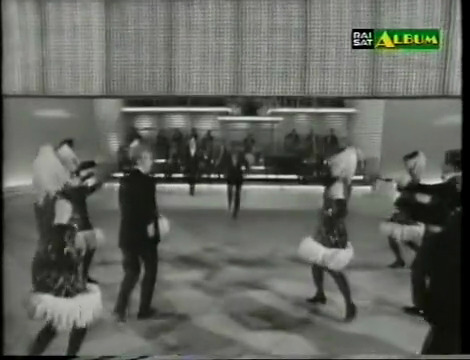
The studios/ Los Estudios (Prado Del Rey). Copyrights RTVE.
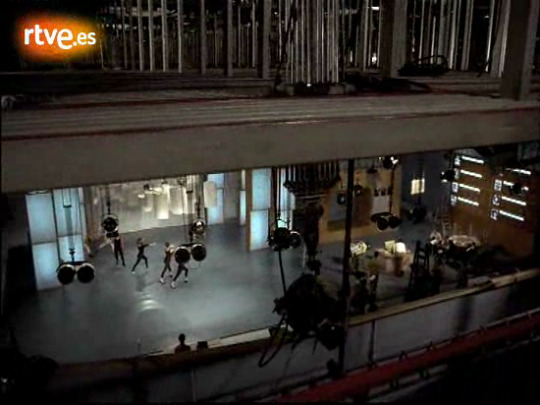

Episode Screenshort. Copyrights Disney TVA.

Mi version:
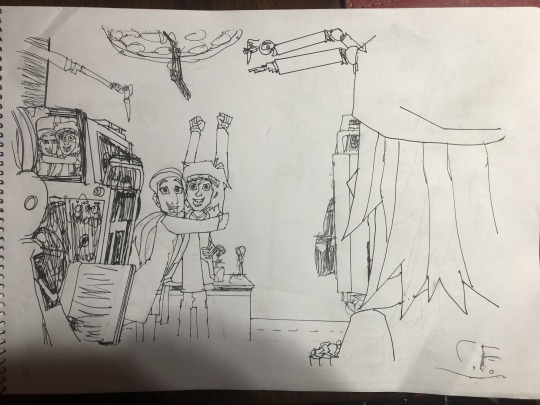
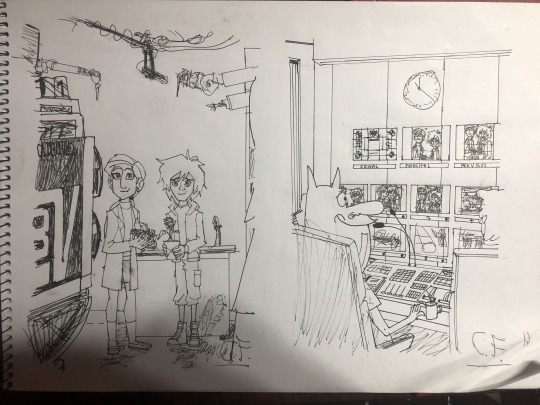
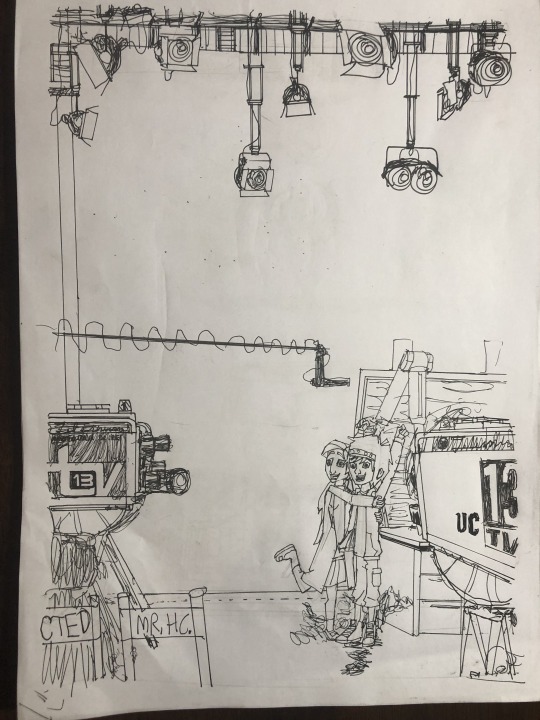
In english:
here, from the most BIG ANIMATED STUDIO OF THE WOLRD, THE FAMOUS STUDIO-ESTUDIO 1 OF THE CPRCATV OF PRADO DEL REY, In middle the famous variety tv program “Studio Uno”, FICCTICEMENT to charge of Disney TVA, The Channel 13 of The Television Corporation of the Pontifical Catholic University of Chile and The Original Producteds, The RAI, in this ocation, traveling to the sience and technology world, Karmi and Hiro to recreate an experiment about microbot how in the scennes of the episode “City Of Monsters pt1″ of “Big Hero 6: The Series”, to Fred’s Comes to the place and help to theys. Some to view the control room from the studio, The TV Cameras are model RCA TK60. Afther of this, Frank Sinatra and His Orchestra SInning beauiful songs. The studio, here is how are in the 60′s and 70′s in the Prado Del Rey Studios. The orchestra directed by SIR Valentín Trujillo
For more information, Studio Uno is the most variety music show in the RAI’s history, In air of 1961 to 1966 in RAI1, Directed, by Antonello Falqui and Guido Sacerdote. Some of the scritps and music, this tv program in sonsidered how of culte in Europe in reference to the withe and black tv in the 60′s.
En Español.
Aquí, desde el plato de animación y de tv mas grande del mundo, el famoso estudio 1 de Prado Del Rey, se graba el famoso programa “Sudio Uno”, producido ficticia-mente por La RAI, Disney TVA Y La Corporación De Televisión De La Pontificia Universidad Católica De Chile, en esta ocasión mostrando un lindo viaje al mundo de la ciencia y la tecnología.
En este sketch, vemos a Karmi y a Hiro recreando un experimento sobre microbots, tal cual como en las escenas del episodio “City Of Monsters pt1″ de Grandes Héroes La Serie, Luego Fred llega al lugar e interrumpe y ayuda a ellos a terminar su trabajo. Después de ello, al otro lado del set, con la orquesta de SIR Valentín Trujillo, Llega al estudio “The Voice”, Frank Sinatra a cantar hermosas canciones con su estilo. Los equipos son reales, ademas de lo que se uso en ese episodio de la serie (equipos científicos) Las camaras son modelo RCA TK60 Y EL ESTUDIO ASI ERA PRADO DE REY EN SUS AÑOS DORADOS.
Para mas info, Studio Uno es considerado como el programa de variedades mas famoso e iCónico en la historia de la RAI, Desde 1961 a 1966, bajo la dirección de Antonello Falqui y Guido Sacerdote, con música y variedades, es considerada como una serie de culto en Europa e icono de la variety europea de la televisión en blanco y negro de los años 60.
Referencia:
https://www.raicultura.it/cinema/articoli/2019/05/Studio-Uno-c821b7db-51a1-4ad3-babc-d89de0358710.html
https://it.wikipedia.org/wiki/Studio_Uno_(programma_televisivo)
Los Estudios
https://es.wikipedia.org/wiki/Estudios_de_Prado_del_Rey
https://en.wikipedia.org/wiki/Prado_del_Rey_(studios)
and seach studio uno rai in youtube
Copyrights
Kamri, Hiro and Ferd
© Disney / Marvel / Man Of Action / Claremont / Nakayama. All Rights Reserved.
Red Guy
© David Feiss / Cartoon Netowork. All Rights Reserved.
Prado Del Rey
© RTVE. All Rights Reserved.
Studio Uno
© RAI, Radiotelevizione Italiana S.p.A. All Rights Reserved.
#Crosover#crossover fanart#estudios prado del rey#television#variety#studio uno rai#bh6 fred#Red guy#karmi#Hiro Hamada#bh6 karmi#bh6 hiro#bh6 the series#karmiro
2 notes
·
View notes
Text
Events 9.13
585 BC – Lucius Tarquinius Priscus, king of Rome, celebrates a triumph for his victories over the Sabines, and the surrender of Collatia.
509 BC – The Temple of Jupiter Optimus Maximus on Rome's Capitoline Hill is dedicated on the ides of September.
379 – Yax Nuun Ahiin I is crowned as 15th Ajaw of Tikal
533 – Belisarius of the Byzantine Empire defeats Gelimer and the Vandals at the Battle of Ad Decimum, near Carthage, North Africa.
1229 – Ögedei Khan is proclaimed Khagan of the Mongol Empire in Kodoe Aral, Khentii: Mongolia.
1437 – Battle of Tangier: a Portuguese expeditionary force initiates a failed attempt to seize the Moroccan citadel of Tangier.
1501 – Italian Renaissance: Michelangelo begins work on his statue of David.
1504 – Queen Isabella and King Ferdinand issue a Royal Warrant for the construction of a Royal Chapel (Capilla Real) to be built.
1541 – After three years of exile, John Calvin returns to Geneva to reform the church under a body of doctrine known as Calvinism.
1584 – San Lorenzo del Escorial Palace in Madrid is finished.
1609 – Henry Hudson reaches the river that would later be named after him – the Hudson River.
1645 – Wars of the Three Kingdoms: Scottish Royalists are defeated by Covenanters at the Battle of Philiphaugh.
1743 – Great Britain, Austria and the Kingdom of Sardinia sign the Treaty of Worms.
1759 – Battle of the Plains of Abraham: the British defeat the French near Quebec City in the Seven Years' War, known in the United States as the French and Indian War.
1782 – American Revolutionary War: Franco-Spanish troops launch the unsuccessful "grand assault" during the Great Siege of Gibraltar.
1788 – The Philadelphia Convention sets the date for the first presidential election in the United States, and New York City becomes the country's temporary capital.
1791 – King Louis XVI of France accepts the new constitution.
1808 – Finnish War: In the Battle of Jutas, Swedish forces under Lieutenant General Georg Carl von Döbeln beat the Russians, making von Döbeln a Swedish war hero.
1812 – War of 1812: A supply wagon sent to relieve Fort Harrison is ambushed in the Attack at the Narrows.
1814 – In a turning point in the War of 1812, the British fail to capture Baltimore. During the battle, Francis Scott Key composes his poem "Defence of Fort McHenry", which is later set to music and becomes the United States' national anthem.
1843 – The Greek Army rebels (OS date: September 3) against the autocratic rule of king Otto of Greece, demanding the granting of a constitution.
1847 – Mexican–American War: Six teenage military cadets known as Niños Héroes die defending Chapultepec Castle in the Battle of Chapultepec. American troops under General Winfield Scott capture Mexico City in the Mexican–American War.
1848 – Vermont railroad worker Phineas Gage survives an iron rod 1+1⁄4 inches (3.2 cm) in diameter being driven through his brain; the reported effects on his behavior and personality stimulate discussion of the nature of the brain and its functions.
1862 – American Civil War: Union soldiers find a copy of Robert E. Lee's battle plans in a field outside Frederick, Maryland. It is the prelude to the Battle of Antietam.
1882 – Anglo-Egyptian War: The Battle of Tel el-Kebir is fought.
1898 – Hannibal Goodwin patents celluloid photographic film.
1899 – Henry Bliss is the first person in the United States to be killed in an automobile accident.
1899 – Mackinder, Ollier and Brocherel make the first ascent of Batian (5,199 m – 17,058 ft), the highest peak of Mount Kenya.
1900 – Filipino insurgents defeat a small American column in the Battle of Pulang Lupa, during the Philippine–American War.
1906 – The Santos-Dumont 14-bis makes a short hop, the first flight of a fixed-wing aircraft in Europe.
1914 – World War I: The Battle of Aisne begins between Germany and France.
1922 – The final act of the Greco-Turkish War, the Great Fire of Smyrna, commences.
1923 – Following a military coup in Spain, Miguel Primo de Rivera takes over, setting up a dictatorship.
1933 – Elizabeth McCombs becomes the first woman elected to the New Zealand Parliament.
1942 – World War II: Second day of the Battle of Edson's Ridge in the Guadalcanal Campaign. U.S. Marines successfully defeated attacks by the Japanese with heavy losses for the Japanese forces.
1944 – World War II: Start of the Battle of Meligalas between the Greek Resistance forces of the Greek People's Liberation Army (ELAS) and the collaborationist security battalions.
1948 – Deputy Prime Minister of India Vallabhbhai Patel orders the Army to move into Hyderabad to integrate it with the Indian Union.
1948 – Margaret Chase Smith is elected United States senator, and becomes the first woman to serve in both the U.S. House of Representatives and the United States Senate.
1953 – Nikita Khrushchev is appointed General Secretary of the Communist Party of the Soviet Union.
1956 – The IBM 305 RAMAC is introduced, the first commercial computer to use disk storage.
1956 – The dike around the Dutch polder East Flevoland is closed.
1962 – An appeals court orders the University of Mississippi to admit James Meredith, the first African-American student admitted to the segregated university.
1964 – South Vietnamese Generals Lâm Văn Phát and Dương Văn Đức fail in a coup attempt against General Nguyễn Khánh.
1964 – Martin Luther King Jr. addresses a crowd of 20,000 West Berliners on Sunday, in Waldbühne.
1968 – Cold War: Albania leaves the Warsaw Pact.
1971 – State police and National Guardsmen storm New York's Attica Prison to quell a prison revolt, which claimed 43 lives.
1971 – Chairman Mao Zedong's second in command and successor Marshal Lin Biao flees China after the failure of an alleged coup. His plane crashes in Mongolia, killing all aboard.
1977 – General Motors introduces Diesel engine, with Oldsmobile Diesel engine, in the Delta 88, Oldsmobile 98, and Oldsmobile Custom Cruiser models amongst others.
1979 – South Africa grants independence to the "homeland" of Venda (not recognised outside South Africa).
1982 – Spantax Flight 995 crashes at Málaga Airport during a rejected takeoff, killing 50 of the 394 people on board.
1985 – Super Mario Bros. is released in Japan for the NES, which starts the Super Mario series of platforming games.
1987 – Goiânia accident: A radioactive object is stolen from an abandoned hospital in Goiânia, Brazil, contaminating many people in the following weeks and causing some to die from radiation poisoning.
1988 – Hurricane Gilbert is the strongest recorded hurricane in the Western Hemisphere, later replaced by Hurricane Wilma in 2005 (based on barometric pressure).
1989 – Largest anti-Apartheid march in South Africa, led by Desmond Tutu.
1993 – Israeli Prime Minister Yitzhak Rabin shakes hands with Palestine Liberation Organization chairman Yasser Arafat at the White House after signing the Oslo Accords granting limited Palestinian autonomy.
1997 – A German Air Force Tupolev Tu-154 and a United States Air Force Lockheed C-141 Starlifter collide in mid-air near Namibia, killing 33.
2001 – Civilian aircraft traffic resumes in the United States after the September 11 attacks.
2007 – The Declaration on the Rights of Indigenous Peoples is adopted by the United Nations General Assembly.
2007 – The McLaren F1 team were found guilty of possessing confidential information from the Ferrari team, and were fined $100 million and were excluded from the constructors' championship standings.
2008 – Delhi, India, is hit by a series of bomb blasts, resulting in 30 deaths and 130 injuries.
2008 – Hurricane Ike makes landfall on the Texas Gulf Coast of the United States, causing heavy damage to Galveston Island, Houston, and surrounding areas.
2013 – Taliban insurgents attack the United States consulate in Herat, Afghanistan, with two members of the Afghan National Police reported dead and about 20 civilians injured.
2018 – The Merrimack Valley gas explosions: One person is killed, 25 are injured, and 40 homes are destroyed when excessive natural gas pressure caused fires and explosions.
3 notes
·
View notes
Text
Todos os filmes em que as cenas de sexo foram para valer
A Bula reuniu em uma lista todos os filmes da história do cinema nos quais os atores se envolvem em atos sexuais reais, não simulados. A diferença entre esses longas e a pornografia é que, embora possam ser considerados eróticos, a trama deles não é meramente pornográfica. Ao todo, a lista conta com 264 títulos.

A Bula reuniu em uma lista todos os filmes da história do cinema nos quais os atores se envolvem em atos sexuais reais, não simulados. Nos Estados Unidos, esse tipo de cena era proibido no cinema convencional, mas a partir dos Anos 1960 os cineastas começaram a ultrapassar os limites. A diferença entre esses longas e a pornografia é que, embora possam ser considerados eróticos, a trama deles não é meramente pornográfica. A maioria deles foi lançada nos anos 1970 e 80, com predominância de dois diretores: o espanhol Jesús Franco e o italiano Joe D’Amato. Por repetidas vezes, também aparecem os nomes de cineastas consagrados atualmente, como Lars von Trier, Gaspar Noé e Yorgos Lanthimos.
1 — Gift (1966), Knud Leif Thomsen
2 — They Call Us Misfits (1968), Stefan Jarl
3 — F*uck (1969), Andy Warhol
4 — 99 Mulheres (1969), Stefen Thrower
5 — Double Face (1969), Riccardo Freda
6 — Quiet Days in Clichy (1970), Jens Jørgen Thorsen
7 — Groupie Girl (1970), Drek Ford
8 — The Deviates (1970), Eduardo Cemano
9 — Bacchanale (1970), John Amero
10 — Kama Sutra ’71 (1970), Raj Devi
11 — Cry Uncle! (1971), John G. Avildsen
12 — Slaughter Hotel (1971), Fernando Di Leo
13 — Uma Lagartixa num Corpo de Mulher (1971), Lucio Fulci
14 — Luminous Procuress (1971), Steven F. Arnold
15 — Secret Rites (1971), Drek Ford
16 —A Clockwork Blue (1972), Eric Jeffrey Haims
17 — Pink Flamingos (1972), John Waters
18 — Who Killed the Prosecutor and Why? (1972), Giuseppe Vari
19 — La Verità Secondo Satana (1972), Ronato Polselli
20 — So Sweet, So Dead (1972), Rose et Val
21 — The Red Headed Corpse (1972), Renzo Russo
22 — Commuter Husbands (1972), Derek Ford
23 — Delirium (1972), Renato Polselli
24 — Christina, the Devil Nun (1972), Sergio Bergonzelli
25 — Danish Pastries (1973), Finn Karlsson
26 — Ingrid the Streetwalker (1973), Brunello Rondi
27 — Thriller – Um Filme Cruel (1973), Bo Arne Vibenius
28 — Revelations of a Psychiatrist on the World of Sexual Perversion (1973), Renato Polselli
29 — A Scream in the Streets (1973), Carl Monson
30 — The Devil In Miss Jones (1973), Gerard Damiano
31 — Fleshpot on 42nd Street (1973), Andy Milligan
32 — The Other Side of the Mirror (1973), Jess Franco
33 — Diary of a Nynphomaniac (1973), Jesús Franco
34 — A Virgem e os Mortos (1973), Jesús Franco
35 — O Reduto dos Monstros (1973), Vidal Raski
36 — The Devil’s Plaything (1973), Joseph W. Sarno
37 — Anita (1973), Torgny Wickman
38 — The Sex Thief (1973), Martin Campbell
39 — The Porn Brokers (1973), John Lindsay
40 — Emmanuelle (1974), Just Jaeckin
41 — The Eerie Midnight Horror Show (1974), Mario Gariazzo
42 — Zelda (1974), Alberto Cavallone
43 — I Tyrens Tegn (1974), Werner Hedman
44 — Score (1974), Radley Metzger
45 — Riot on a Women’s Prison (1974), Brunello Rondi
46 — The Girls of Kamare (1974), René Viénet
47 — La Bonzesse (1974), François Jouffa
48 — Sweet Movie (1974), Dušan Makavejev
49 — Fiossie (1974), Marie Forsa
50 — Contos Imorais (1974), Walerian Borowczyk
51 — Lorna: O Exorcista (1974), Jesús Franco
52 — Countess Perverse (1974), Jesús Franco
53 — Carnal Revenge (1974), Alfredo Rizzo
54 — Keep It Up, Jack! (1974), Derek Ford
55 — The Hot Girls (1974), John Lindsay
56 — Voodoo Sexy (1974), Osvaldo Civirani
57 — Nude for Satan (1974), Luigi Batzella
58 — In the Sign of the Gemini (1974), Werner Hadman
59 — Come To My Bedside (1975), John Hillbard
60 — The Image (1975), Radley Metzger
61 — Número Dois (1975), Jean-Luc Godard
62 — The Teenage Prostitution Racket (1975), Carlo Lizzani
63 — Emanuelle Nera (1975), Bitto Albertini
64 — Emanuelle’s Revenge (1975), Joe D’Amato
65 — Felicia (1975), Max Pécas
66 — But Who Raped Linda? (1975), Jesús Franco
67 — A Maldição da Vampira (1975), Jesús Franco
68 — Les Chatouilleuses (1975), Jesús Franco
69 — L’Éventreur de Notre-Dame (1975), Jesús Franco
70 — Justine e Juliette (1975), Mac Ahlberg
71 — The Bloodsucker Leads the Dance (1975), Alfredo Rizzo
72 — Lábios de Sangue (1975), Jean Rollin
73 — Rêves Pornos (1975), Max Pécas
74 — Wham! Bam! Thank You, Spaceman! (1975), William A. Levey
75 — Breaking Point (1975), Bo Arne Vibenius
76 — Rolls-Royce Baby (1975), Erwin C. Dietrich
77 — Girls Come First (1975), Joseph McGrath
78 — The Sexplorer (1975), Derek Ford
79 — Le Sexe qui Parle (1975), Claude Mulot
80 — Barbie Wire Dolls (1975), Jesús Franco
81 — Emanuelle em Bangkok (1975), Joe D’Amato
82 — Lust (1976), Max Pécas
83 — The Opening of Misty Beethoven (1976), Radley Metzger
84 — Alice in Wonderland: An X-Rated Musical Fantasy (1976), Bud Townsend
85 — Bedside Sailors (1976), John Hillbard
86 — In The Sign of the Lion (1976), Werner Hedman
87 — O Império dos Sentidos (1976), Nagisa Oshima
88 —Through the Looking Glasses (1976), Jonas Middleton
89 — A Real Young Girl (1976), Catherine Breillat
90 — Die Marquise von Sade (1976), Jesús Franco
91 — Girls in the Night Traffic (1976), Jesús Franco
92 — The French Governess (1976), Demofilo Fidani
93 — Inhibition (1976), Paolo Poetti
94 — Around the World in 80 Beds (1976), Jesús Franco
95 — Sex Express (1976), Derek Ford
96 — Keep It Up Downstairs (1976), Robert Young
97 — Secrets of a Superstud (1976), Morton L Lewis
98 — The Office Party (1976), David Grant
99 — The Angel and The Woman (1976), Gilles Carle
100 — Agent 69 in the Sign of Scorpio (1977), Werner Hedman
101 — Shining Sex (1977), Werner Hedman
102 — Fate la nanna coscine di pollo (1977), Amasi Damiani
103 — Blue Rita (1977), Jesús Franco
104 — Emanuelle na América (1977), Joe D’Amato
105 — Emanuelle Around the World (1977), Joe D’Amato
106 — Sister Emanuelle (1977), Giuseppe Vari
107 — Nazi Love Camp 27 (1977), Mario Caiano
108 — Under The Bed (1977), David Grant
109 — The Mark (1977), Ilias Mylonakos
110 — The Cerimony (1977), Omiros Efstratiadis
111 — Monsieur Sade (1977), Jacques Robin
112 — Caligula’s Hot Nights (1977), Roberto Bianchi
113 — Agent 69 Jensen in the Sign of Sagittarius (1978), Werner Hedman
114 — Behind Convent Walls (1978), Walerian Borowczyk
115 — Blue Movie (1978), Alberto Cavallone
116 — Sister of Ursula (1978), Enzo Milloni
117 — The Coming of Sin (1978), José Ramón Larraz
118 — Pleasure Shop on the Avenue (1978), Joe D’Amato
119 — You’re Driving Me Crazy (1978), David Grant
120 — Immoral Women (1979), Walerian Borowczyk
121 — Caligula (1979), Bob Guccione
122 — Images In a Convent (1979), Joe D’Amato
123 — Play Model (1979), Mario Gariazzo
124 — Giallo a Venezia (1979), Mario Landi
125 — Malabimba (1979), Andrea Bianchi
126 — A Prisão (1980), Oswaldo de Oliveira
127 — Beast in Space (1980), Alfonso Brescia
128 — Blow Job (1980), Alberto Cavallone
129 — La Gemella Erotica (1980), Alberto Cavallone
130 — Erotic Nights of the Living Dead (1980), Joe D’Amato
131 — Orgasmo Nero (1980), Joe D’Amato
132 — Flying Sex (1980), Joe D’Amato
133 — Libidomania (1980), Bruno Mattei
134 — When love is obscenity (1980), Roberto Polselli
135 — Hard Sensation (1980), Joe D’Amato
136 — Hotel Paradise (1980), Edoardo Mulargia
137 — Sex and Black Magic (1980), Joe D’Amato
138 — Porno Esotic Love (1980), Joe D’Amato
139 — The Porno Killers (1980), Roberto Mauri
140 — Sem Controle (1980), Paul Verhoeven
141 — Táxi para o Banheiro (1980), Frank Ripploh
142 — Os Frutos da Paixão (1981), Shuji Terayama
143 — Emmanuelle in Soho (1981), David Hughes
144 — Porno Holocaust (1981), Joe D’Amato
145 — Calígula: A História que Não Foi Contada (1982), Joe D’Amato
146 — Scandale (1982), George Mihalka
147 — Apocalipsis Sexual (1982), Carlos Aured
148 — Aphrodite (1982), Robert Fuest
149 — Il Nano Erotico (1982), Alberto Cavallone
150 — My Nights With Messalina (1982), Jaime J. Puig
151 — The Virgin for Caligula (1982), Jaime J. Puig
152 — Luz del Fuego (1982), David Neves
153 — Perdida em Sodoma (1982), Nilton Nascimento
154 — Killing of the Flesh (1983), Cesari Canevari
155 — Satan’s Baby Doll (1983), Mario Bianchi
156 — Taking Tiger Mountain (1983), Tom Huckabee
157 — Emmanuelle 4 (1984), Francis Leroi
158 — Lilian, The Perverted Virgin (1984), Jesús Franco
159 — Alcova (1985), Joe D’Amato
160 — James Joyce’s Women (1985), Michael Pearce
161 — Diabo no Corpo (1986), Marco Bellocchio
162 — Emmanuelle 5 (1987), Walerian Borowczyk
163 — Emmanuelle 6 (1988), Bruno Zincone
164 — Hotel St. Pauli (1988), Svend Wan
165 — Kindergarten (1989), Jorge Polaco
166 — Kinski Paganini (1989), Klaus Kinski
167 — Tokyo Decadence (1992), Ryu Murakami
168 — The Soft Kill (1994), Eli Cohen
169 — A Vida de Jesus (1997), Bruno Dumont
170 — Os Idiotas (1998), Lars von Trier
171 — O Tédio (1998), Cédric Kahn
172 — Fiona (1998), Amos Kollek
173 — Jesus is a Palestinian (1999), Lodewijk Crijns
174 — Romance (1999), Catherine Breillat
175 — Pola X (1999), Leos Carax
176 — The Man-Eater (1999), Aurelio Grimaldi
177 — Olhe por Mim (1999), Davide Ferrario
178 — Vampire Strangler (1999), William Hellfire
179 — Baise-moi (2000), Virginie Despentes
180 — Scrapbook (2000), Eric Stanze
181 — Intimacy (2001), Patrice Chéreau
182 — O Pornógrafo (2001), Bertrand Bonello
183 — Lucia e o Sexo (2001), Julio Medem
184 — Dias de Cão (2001), Ulrich Seidl
185 — O Centro do Mundo (2001), Wayne Wang
186 — La Novia de Lázaro (2002), Fernando Merinero
187 — Le loup de la côte Ouest (2002), Hugo Santiago
188 — Eternamente Sua (2002), Apichatpong Weerasethakul
189 — Coisas Secretas (2002), Jean-Claude Brisseau
190 — Ken Park (2002), Larry Clark
191 — Brown Bunny (2003), Vincent Gallo
192 — Faça Isto (2003), Tinto Brass
193 — Rossa Venezia (2003), Andreas Bethmann
194 — The Principles of Lust (2003), Penny Woolcock
195 — Anatomia do Inferno (2004), Catherine Breillat
196 — 9 Canções (2004), Michael Winterbottom
197 — Story of The Eye (2004), Georges Bataille
198 — Kärlekens språk (2004), Anders Lennberg
199 — Garotinho Bobo (2004), Lionel Baier
200 — All About Anna (2005), Jessica Nilsson
201 — 8mm 2 (2005), J. S. Cardone
202 — Beijando na Boca (2005), Joe Swanberg
203 — O Sabor da Melancia (2005), Tsai Ming-Liang
204 — Princesas (2005), Fernando Léon de Aranoa
205 — Deite Comigo (2005), Clement Virgo
206 — Destricted (2006), Gaspar Noé e outros
207 — Shortbus (2006), John Cameron Mitchell
208 — Taxidermia (2006), Gyorgy Pálfi
209 — Os Anjos Exterminadores (2006), Jean-Claude Brisseau
210 — Amour Fou (2007), Felicitas Korn
211 — Ex Drummer (2007), Koen Mortier
212 — Its Fine. Everything is Fine! (2007), David Brothers
213 — The Story of Richard O (2007), Damien Odoul
214 — Import Export (2007), Ulrich Seidl
215 — Serviço (2008), Brillante Mendoza
216 — Tropical Manila (2008), Sang-woo Lee
217 — Otto, ou Viva Gente Morta (2008), Bruce LaBruce
218 — À l’aventure (2008), Jean-Claude Brisseau
219 — Amateur Porn Star Killer 2 (2008), Shane Ryan
220 — Gutterballs (2008), Ryan Nicholson
221 — House of Flesh Mannequins (2009), Domiziano Cristopharo
222 — Anticristo (2009), Lars von Trier
223 — Viagem Alucinante (2009), Gaspar Noé
224 — The Band (2009), Anna Brownfield
225 — Canino (2009), Yorgos Lanthimos
226 — Angels With Dirty Wings (2009), Roland Reber
227 — Now & Later (2009), Philippe Diaz
228 — Bedways (2010), Rolf Peter Kahl
229 — Rio Sex Comedy (2010), Jonathan Nossiter
230 — The Bunny Game (2010), Adam Rehmeier
231 — Ano Bissexto (2010), Michael Rowe
232 — Gandu (2010), Qaushiq Mukherjee
233 — LelleBelle (2011), Mischa Kamp
234 — Desire (2011), Laurent Bouhnik
235 — O Amor é um Saco! (2011), Scud
236 — Caged (2011), Stephan Brenninkmeijer
237 — Léa (2011), Bruno Rolland
238 — The Wrong Ferrari (2011), Adam Green
239 — Clip (2011), Maja Milos
240 — Uma Estranha Amizade (2012), Sean S. Baker
241 — Paradise: Faith (2012), Ulrich Seidl
242 —And They Call It Summer (2012), Paolo Franchi
243 — I Want Your Love (2012), Travis Mathews
244 — Crônicas Sexuais de Uma Família Francesa (2012), Pascal Arnold
245 — Azul é a Cor Mais Quente (2013), Abdellatif Kechiche
246 — Ninfomaníaca (2013), Lars von Trier
247 — Pornopung (2013), Johan Kaos
248 — O Desconhecido do Lago (2013), Alain Guiraudie
249 — Zonas Úmidas (2013), David Wnendt
250 — Pasolini (2014), Abel Ferrara
251 — Diet of Sex (2014), Borja Brun
252 — Angry Painter (2015), Kyu-hwan Jeon
253 — Love (2015), Gaspar Noé
254 — Muito Amadas (2015), Nabil Ayouch
255 —Theo e Hugo (2016), Olivier Ducastel
256 — Tenemos la Carne (2016), Emiliano Rocha Minter
257 — Needle Boy (2016), Alexander Bak Sagmo
258 — Love Machine (2016), Pavel Ruminov
259 — A Noite (2016), Edgardo Castro
260 — A Thought of Ecstasy (2017), Rolf Peter Kahl
261 — Ana, Meu Amor (2017), Calin Peter Netzer
262 — Picture of Beauty (2017), Maxim Ford
263 — Marfa Girl 2 (2018), Larry Clark
264 — Mektoub, My Love: Intermezzo (2018), Abdellatif Kechiche
Todos os filmes em que as cenas de sexo foram para valer Publicado primeiro em https://www.revistabula.com
14 notes
·
View notes
Text
The Mexican indigenous artists who are defying labels and stereotypes
New Post has been published on http://khalilhumam.com/the-mexican-indigenous-artists-who-are-defying-labels-and-stereotypes/
The Mexican indigenous artists who are defying labels and stereotypes

We are sharing our visual libraries to inspire future generations of illustrators
The people from Malacateticpac, 2015, by the author, Isela Xospa.
My name is Isela Xospa and I am a freelance illustrator and editor. The graphic design project that I am developing is the result of a personal journey to find ways of asserting my indigenous identity in a contemporary and transnational context. Discovering and embracing my indigenous identity has given me the tools to build new ways of sharing an inner world that is heavily influenced by the culture of the indigenous people living south of Mexico City.
Night of the paper balloons, 2019, by the author, Isela Xospa.
For the International Day of the World’s Indigenous Peoples on August 9, I decided to share the work of young illustrators of indigenous origin and I am sharing them again in this article. I wanted to do this because there are not many illustrators out there who identify as indigenous. The other reason was that, far from trying to stereotype, I believe it is important to publish their work as a provocation that seeks to challenge the imagery and labels assigned to indigenous people and their representations. We must not waste these opportunities to question the formats and styles that are used to represent indigenous groups in the world of illustration. These should be treated as windows of opportunity to rebel against the imposition of the non-indigenous, to make our political stances known and to put forward suggestions, outcomes and ideas to encourage the creation of new narratives and readings, made by and for the indigenous population. For us, the International Day of the World's Indigenous Peoples is not a celebration of labels, customs or exoticisms. Instead, it must acknowledge the systematic attempts to erase us and to integrate us into a nation-state project, which has led to the loss of languages, territories, clothing, knowledge, health and opportunities of indigenous peoples. From the small place that inspired our creativity, some of us with our political views and others with the prevailing need to express ourselves vividly and visually, we will continue to create narratives for children, young people and adults from native populations. We hope that our stories will touch, transform and impact future generations of graphic storytellers who return to, use and embrace their culture. From our creative spaces, we share with you our visual libraries.
Social media:
Xospatronik
XospatronikNYC
@EXospatronik
Mitzy Juárez
Mitzy Juárez is an illustrator and graphic designer from the Chocholteco Ngiba indigenous tribe in Oaxaca, southern Mexico. She was born and raised in a small, remote town on the plains of the Mixteca region of Oaxaca, home to the area’s most beautiful natural springs. The inspiration for Mitzy's drawings comes from the people, the language and the traditions with which she grew up. Through drawing, she has found a way of preserving the knowledge that she inherited from her community—the knowledge that she carries with her wherever she goes.
View this post on Instagram
¡De la Milpa a la ciudad vino el elotito en el viento, cruzando mares y ríos, llanos, veredas y cerros! (Gabriel del Río) ¡Tchíxa! ¡El elotito! #inktober #chocholteco #ngiba #lenguasoriginarias #ilustración #winsorandnewton #pentel #ilustradoramexicana #elote #maiz #corn #illustration #nativelanguages
A post shared by Mitzy Juárez (@mitzyjuarez.jpg) on Oct 18, 2019 at 12:40pm PDT
//www.instagram.com/embed.js
The little corn was carried by the wind from the Milpa farms to the city, crossing seas and rivers, plains, roads and mountains! (Gabriel del Río) It's Tchíxa, the little corn!
Social media:
Mitzy Juárez
Mitzy Juárez
David Canul, el pájaro Toj (the ‘Toj’ bird)
David Canul is originally from the Mayan territory of Campeche on the Gulf of Mexico. His hybrid work as a professional illustrator ranges from research books, poetry, content for children and even ceramics. He is also involved in organising, managing and promoting children’s and young adult literature festivals in the Yucatán Peninsula.
View this post on Instagram
Fantasías en bicicleta Técnica: scratch y color digital #scratch #pajarotojilustrador #drawing #illustration #illustratoroninstagram #illustragram #ilustracióninfantil #lij #illustrationartists #illustrationartist #illustrated #librosparaniños #illustracion #moreillustrations #illustrationnow #theillustrationroom #illustrator #illustratrice #illustrationoftheday #illustratorsoninstagram #instaart #instaartist #instartists #xolo #childrensbooks #creativeart #art_spotlight #artwork #artistoninstagram #art
A post shared by PájaroToj Ilustrador (@pajarotoj.ilustrador) on Mar 5, 2020 at 3:36pm PST
//www.instagram.com/embed.js
Bicycle Fantasies
Technique: scratch and digital colour
Social media:
Pájaro Toj Ilustrador
El Pájaro Toj
Griss Romero
An element that stands out in Griss Romero's work is the jaguar, also known as “tekuani” or “tiger” and is one of the most important identity symbols in the state of Guerrero. Griss finds inspiration in the ancestral roots and culture of the Nahua community in Acatlán. She uses her art as a tool to raise awareness of the indigenous peoples in the state of Guerrero in southwestern Mexico, and to showcase their agricultural beliefs and rituals. Griss currently has a piece featured in the Poetics of Colour virtual art exhibition and will soon feature in the virtual exhibition “FROM MY WINDOW — Longing of an Artist in Quarantine”.
View this post on Instagram
A post shared by Griss Romero (@grisssromero) on Aug 11, 2020 at 7:10am PDT
//www.instagram.com/embed.js
Social media:
Griss Romero
Griss Romero
Cuauhtémoc Wetzka
Cuauhtémoc Wetzka is a graphic designer and illustrator who has exhibited works in Argentina, Colombia, Spain, France, Estonia, Poland, China, Canada and the United States. Cuauhtémoc is from the Nahua community of the Sierra de Zongolica located in the central region of the state of Veracruz, which lies along Mexico's Atlantic coast. In 2015, he was awarded first place in the Mexican National Council for Culture and Arts’ 25th Catalogue of Illustrators for Children's and Young Adult Publications. In the same year, he was also a finalist in the Art Contest and Exhibition for Children by Hispanic Artists in Las Vegas, Nevada. He has also spoken at various international conferences and has been recognised for his work on printed posters.
View this post on Instagram
A post shared by Cuauhtemoc Wetzka (@cuauhtemocwetzka) on Jun 25, 2019 at 2:41pm PDT
//www.instagram.com/embed.js
Social media:
Behance: Cuauhtémoc Wetzka
Cuauhtémoc Wetzka
Wetzka Temo
Gil Kupyum (Gilberto Delgado)
Gilberto Kupyum is from Tlahuitoltepec Mixe, an indigenous community located in Oaxaca's northwest region, an area of fog and forest. In his work, he uses themes such as nature, oral tradition and music, which he captures in various media, for example, painting, screen printing, engraving, lithography and ceramics. His real name is Gilberto Delgado but is called Gil Kupyum or Mish Kupyum by his friends, which means “woodpecker boy” in the Ayuujk language. He identifies with this bird because wood carvings are used in graphic design. Gilberto Kupyum also works with women and young people from his community. Together they make bags, shirts, notebooks, prints and other products to create a source of community employment.
View this post on Instagram
#rompecabezas
A post shared by Gil Kupyum (@kupyum) on Jun 7, 2020 at 2:47pm PDT
//www.instagram.com/embed.js
Social media:
Gil Kupyum
Gilberto Kupyum
Valentín Peralta
Valentín Peralta Betanzos belongs to the Mazatec indigenous group and is originally from the town of Eloxochitlán de Flores Magón, one of the 45 municipalities that make up the Cañada region of Oaxaca. Valentín admits that he is attracted to the contemporary world and incorporates new concepts and materials into his current works while focusing on variety since he believes that art is a language and an expression of all the senses.
View this post on Instagram
MARIA SABINA Un homenaje a maria sabina ,mujer mazateca ….. conocida como la "sacerdotisa de los hongos sagrados" . Algo que me gusto mucho hacer , cuando te acuerdas de aquellas montañas tan llenas de vida…. a la gente que te rodea ,los rostros y las miradas …. modelado en plastilina. #arteoaxaca #modelingclay #plastilina #art #plasticine #hechoamano
A post shared by Valentin peralta (@plastivaleando) on Jun 23, 2019 at 5:21pm PDT
//www.instagram.com/embed.js
MARIA SABINA
A homage to Maria Sabina, a Mazatec woman known as the “priestess of the sacred mushrooms.” This is something I really enjoy doing…when you remember those mountains that are so full of life, the people that surround you, the faces and the gazes…modelled in plasticine.
Social media:
Valentín Peralta
Valentín Peralta
Vics Gaspar
Victoria Gaspar Teodocio is a Zapotec woman descended from the San Melchor Betaza community in Oaxaca. She is an illustrator who studied Graphic Design at the National Autonomous University of Mexico. Vics uses her illustrations on handmade notebooks and silkscreen prints in different media, and also enjoys working on documentary and portrait photography. The protagonists in Vic's art are women expressing their freedom, passion and love. Her illustrations are a tribute to her mother, grandmothers, and all the women who have had an influence on her life. Vic is part of the mountain group called Dill Yel Nbán, which focuses on promoting the Zapotec language.
View this post on Instagram
Mujeres músicas de la Sierra Norte de Oaxaca, de San Melchor Betaza y Villa Hidalgo Yalálag. La música serrana es identidad, herencia, canto, luz, fortaleza, alegría, sabiduría, memoria, danza, es historia bordada en huipil, en refajo que no dejará de florecer en comunidad. .

. #ilustracional #illustration #ilustración #ilustradoresmexicanos #ilustradoresmexico #artistasmexicanas #artistasmexicanos
A post shared by Vics Gaspar

(@vics_gate) on Sep 16, 2020 at 3:22pm PDT
//www.instagram.com/embed.js
Female musicians from the towns of San Melchor Betaza and Villa Hidalgo Yalálag in the Sierra Norte de Oaxaca region. Music from the mountains is identity, inheritance, song, light, strength, happiness, wisdom, memory, dance, it is history embroidered in a huipil, in a skirt that will not cease to flourish in the community.
Social media:
Vics Gaspar
Vics Gaspar
Written by Isela Xospa Translated by Emma Dewick · View original post [es]
2 notes
·
View notes